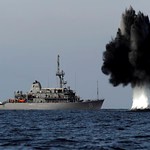President Trump’s directive to the U.S. Navy to retaliate against Iranian harassment and threatening actions against the U.S. Navy reverses the Obama-Biden policy of pacificism that has emboldened Tehran for far too long.
“The president issued an important warning to the Iranians,” Deputy Defense Secretary David L. Norquist said during a Pentagon news conference. “What he was emphasizing is all of our ships retain the right of self-defense, and people need to be very careful in their interactions to understand the inherent right of self-defense.”
The Iranian regime has a history of harassing U.S. vessels operating in the region. Small, quick Iranian boats have charged at U.S. ships in international waters.
The president’s tweet does not signal a new policy, the vice chairman of the Joint Chiefs of Staff said, as U.S. forces in any environment retain the right to defend themselves. “Every ship that deploys in harm’s way has the inherent right of self-defense,” Air Force Gen. John E. Hyten told reporters. “What that means is if we see a hostile act, if we see hostile intent, we have the right to respond, up to and including lethal force.”
The latest incident involved eleven Iranian gunboats threatening several American vessels.
Iran has long used its naval forces to terrorize the international maritime community. In 2015, during negotiations of the Iran Deal and after its adoption, the U.S. Navy recorded 22 incidents of unsafe and unprofessional conduct by the IRGC Navy (IRGCN), many that risked collision. An additional 36 incidents of unsafe and unprofessional conduct were recorded in 2016.
In January 2016 incident, IRGC naval forces seized two U.S. Navy riverine boats and detained ten U.S. sailors for a period of 15 hours, parading them in front of propaganda cameras.
As noted by the U.S. State Department, When President Trump took office, he initiated a comprehensive review of the United States’ Iran policy in light of the Iran Deal’s failure to address the regime’s growing threats to international peace and security. During this review period, Iran continued its dangerous naval activity.
- In March 2017, the USNS Invincible was forced to change course to avoid collision with multiple approaching IRGCN fast-attack small crafts.
- In July 2017, an IRGCN vessel came within 150 yards of the USS Thunderbolt in the Persian Gulf, forcing it to fire warning shots.
- In August 2017, an unarmed Iranian drone flew close to the USS Nimitz as fighter jets landed at night, threatening the safety of the American pilots and crew.
In October 2017, President Trump announced a new Iran policy that made clear the United States would not tolerate the status quo from Iran, nor appease their provocations. Following the President’s announcement, incidents of IRGC naval harassment sharply declined and remained depressed even after the United States left the JCPOA.
In May 2019, Iran began a campaign of provocative actions to extort the world into granting it sanctions relief.
- On May 12, 2019, IRGC naval personnel placed and detonated limpet mines on two Saudi, one UAE, and one Norwegian-registered ships while they were harbored in UAE territorial waters near Fujairah Port.
- On June 13, 2019, IRGC naval personnel placed and detonated limpet mines on one Japanese ship and one Norwegian owned ship while they transited the Gulf of Oman. The U.S. later released a video showing IRGC naval personnel removing one of their limpet mines off the side of the Japanese tanker.
- On June 19, 2019, IRGC personnel deployed a surface-to-air missile to shoot down a U.S. unmanned aircraft lawfully operating near the Strait of Hormuz. IRGC Commander Hossein Salami announced that Iran had shot down the drone, claiming that it was operating over Iran’s territorial waters.
- On July 19, 2019, the IRGC Navy seized the British-flagged, Swedish-owned Stena Impero tanker while it was transiting the Strait of Hormuz. On the same day, the IRGC also temporarily detained the Liberian-flagged Mesdar tanker. The Stena Impero and her crew were detained in Iran for more than two months as negotiating leverage.
At the same time the Iranian regime is seeking sanctions relief, it focuses its resources and efforts to harass the international maritime community.
- On April 14, 2020, the IRGC Navy forcibly boarded and detained the Hong Kong-flagged SC Taipei oil tanker outside of Iran’s territorial sea, and sailed the tanker into towards an IRGC naval base in Iran.
- On April 15, 2020, eleven IRGC Navy small boats disrupted five U.S. naval vessels conducting a routine exercise by repeatedly engaging in high speed, harassing approaches. The Iranian vessels repeatedly crossed the bows and sterns of the U.S. ships coming as close as to within 10 yards of a US Coast Guard Cutter.
In response to the elevated risk posed to commercial vessels transiting the Strait of Hormuz, the United States spearheaded the creation of the International Maritime Security Construct (IMSC), a coalition of eight European, Middle Eastern, and Asian nations committed to ensuring freedom of navigation and the free flow of commerce through the strait. Since the IMSC was stood up in August 2019, Iranian mine attacks have ceased.
Photo: A 2010 demolition charge detonates 1,500 meters from Avenger-class mine countermeasures ship USS Scout. (U.S. Navy photo by Mass Communication Specialist 1st Class Joshua Lee Kelsey/Released)
